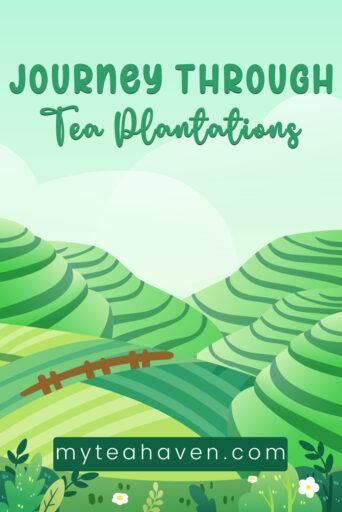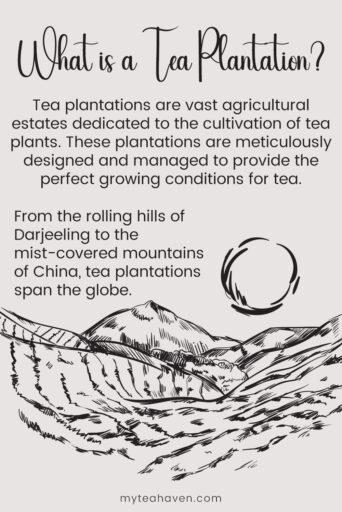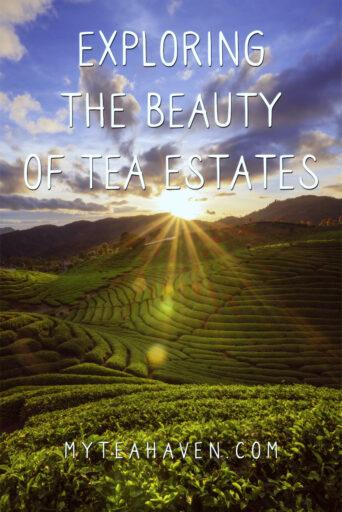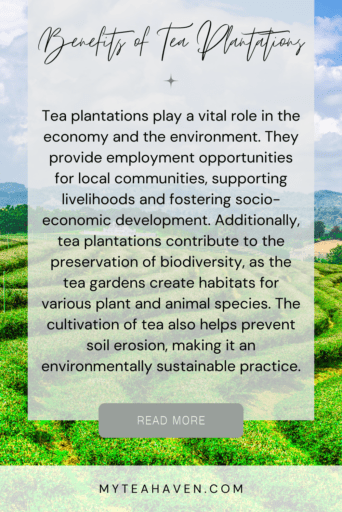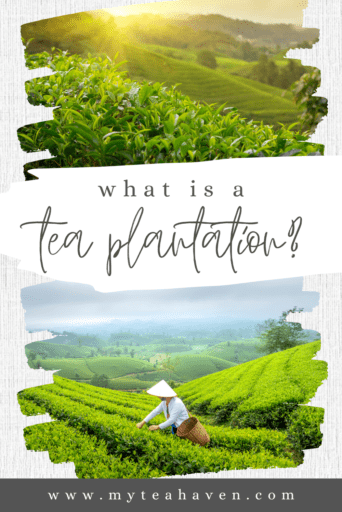Journey Through A Tea Plantation: Exploring Nature’s Brew
The Tea Plantation: A World of Aromatic Elixir
The sprawling landscapes of a tea plantation, the delicate aroma that fills the air, and the intricate process of tea cultivation have always fascinated me. Today I will guide you through the fascinating realm of tea plantations. We’ll learn what they are and how they work, so we can discover the wonderful way tea is grown and cultivated.
We are a participant in the Amazon Services LLC Associates Program, an affiliate advertising program designed to provide a means for us to earn fees by linking to Amazon.com and related sites. This post may contain affiliate links which means we may receive a commission, at no cost to you, for purchases made using our links. Please see my disclosure to learn more. Unless otherwise stated, all prices are in US$.

Homegrown Tea
An Illustrated Guide to Planting, Harvesting, and Blending Teas and Tisanes
Homegrown Tea explains how to grow a large variety of plants in your own garden, on a balcony or even on a window sill could become your tea cupboard. It shows you how to grow your tea from seeds, cuttings, or small plants, as well as which parts of the plant are used to make tea. Liversidge lays out when and how to harvest your plants, as well as information on how to prepare the plant, including how to dry tea leaves to make tea you can store to last you throughout the year.
What is a Tea Plantation?
Tea plantations are vast agricultural estates dedicated to the cultivation of tea plants. These plantations are meticulously designed and managed to provide the perfect growing conditions for tea. From the rolling hills of Darjeeling to the mist-covered mountains of China, tea plantations span the globe. They produce some of the finest tea varieties enjoyed by tea connoisseurs worldwide.
Tea cultivation begins with selecting suitable land, usually in hilly or mountainous regions with specific climatic conditions.
The tea plants thrive in well-drained soil and require a balance of sunlight and shade.

Once the plants are established, they undergo a careful nurturing process, ensuring optimal growth and development.
Types of Tea Plantations
Tea plantations vary across different regions, each imparting a unique character to the tea produced there. From the verdant tea gardens of Assam to the ancient tea trees of Yunnan, the diversity of tea plantations is incredibly vast.
Some notable tea-growing regions include Darjeeling in India, Uji in Japan, and Nuwara Eliya in Sri Lanka. Each region has its own distinct climate, soil composition, and cultivation practices. This results in teas with their own exceptional flavors and aromas!
Benefits of Tea Plantations
Tea plantations play a vital role in the economy and the environment. They provide employment opportunities for local communities, supporting livelihoods and fostering socio-economic development. Additionally, tea plantations contribute to the preservation of biodiversity, as the tea gardens create habitats for various plant and animal species. The cultivation of tea also helps prevent soil erosion, making it an environmentally sustainable practice.
Tea Cultivation Techniques
Successful tea cultivation requires expert techniques and meticulous attention to detail. Tea plantations employ various methods to optimize tea production.

These techniques include pruning the tea bushes to encourage new growth, managing pests and diseases, and ensuring proper irrigation and soil management.
Implementing these practices ensures the health and vitality of the tea plants, resulting in high-quality tea leaves.
Harvesting and Processing
The art of harvesting tea leaves is a delicate process. Skilled tea pluckers selectively handpick the tender leaves, usually consisting of the top two leaves and a bud. This careful selection ensures the highest quality tea. Once harvested, the leaves undergo processing, which includes withering, rolling, oxidation, and drying. Each step contributes to the development of unique flavors and characteristics in the tea.
Tea Plantation Sustainability
Sustainability is a crucial aspect of modern tea plantations. Many tea producers embrace sustainable practices to minimize their environmental impact and protect the delicate ecosystems in which they operate.
Certifications such as Rainforest Alliance and Fairtrade International ensure that tea plantations adhere to rigorous standards, including the protection of biodiversity, conservation of natural resources, and fair treatment of workers. By supporting sustainable tea production, consumers can contribute to the preservation of our planet while enjoying their favorite cup of tea.
Popular Tea Varieties from Plantations
The world of tea plantations offers an extensive range of flavors and aromas. Each tea-growing region produces teas with distinct characteristics, captivating the senses and enticing the palate.
From the bold and malty Assam black teas to the delicate and floral Darjeeling whites, there is a tea for every taste preference.
Some other notable tea varieties include the earthy Pu-erh tea from Yunnan and the vibrant Matcha from Japan. Exploring the diverse range of teas from different plantations is an adventure in itself.


VAHDAM, First Flush Darjeeling Tea 2023 Harvest
Darjeeling tea first flush, popularly known as the “Champagne of Teas”, has black tea leaves and captures the vibrancy of spring. This Darjeeling tea loose leaf has a bright golden liquor and leaves you wanting for more after every sip. Contrary to other Darjeeling tea, this black tea loose leaf is well balanced in strength and has low caffeine.
Visiting Tea Plantations
If you’re a passionate tea lover or simply curious about the tea-making process, visiting a tea plantation can be a truly enriching experience. You can witness firsthand the beauty of the tea gardens, interact with tea workers, and gain insights into the intricacies of tea cultivation.
When planning your visit, consider the best time to go. The tea harvesting seasons vary across different regions, so plan carefully. Embrace the opportunity to immerse yourself in the cultural heritage surrounding tea and discover the captivating stories behind each cup.
Tea Plantation Tourism
In recent years, tea plantation tourism has gained popularity, offering visitors a chance to explore tea-growing regions and engage with local communities. Tea-related tourism provides economic benefits to these regions, boosting local businesses and preserving cultural traditions.
From tea tasting sessions to tea-infused spa treatments, tea plantation tourism offers a wide range of activities for tea enthusiasts and travelers seeking unique experiences.
Tea Plantation Challenges

Like any agricultural industry, tea plantations face their share of challenges. Climate change poses a significant threat, altering weather patterns and affecting tea cultivation.
Pests and diseases also pose risks to tea crops, requiring constant monitoring and appropriate pest management strategies.
That being said, tea researchers and farmers are actively working to develop innovative solutions to combat these challenges and ensure the longevity and sustainability of tea plantations.
The Future of Tea Plantations
Looking ahead, the future of tea plantations is filled with exciting possibilities. Technological advancements are transforming the industry, from precision agriculture techniques to automated processing methods. These innovations aim to enhance productivity, improve quality control, and mitigate environmental impact. Furthermore, the growing interest in organic and specialty teas opens doors for niche tea plantations to flourish. The world of tea is evolving, and tea plantations are at the forefront of this exciting journey!
A Few Final Thoughts
Tea plantations are captivating ecosystems where nature, culture, and craftsmanship intertwine to create the beverage loved by millions. From the meticulous cultivation techniques to the diverse flavors and aromas, tea plantations offer a rich tapestry of experiences.
Whether you’re a seasoned tea aficionado or a curious novice, exploring the world of tea plantations will undoubtedly deepen your appreciation for this ancient elixir. So, embark on this tea-infused journey, savor each sip, and let the wonders of tea plantations transport you to a realm of pure delight.

Tea Gardening for Beginners
Learn to Grow, Blend, and Brew Your Own Tea At Home
What’s more satisfying than brewing the perfect cup of tea? Brewing it from tea you grew yourself! Create your own tea garden with help from this beginner’s guide. It walks you through every step of the process, from planning your garden plot to preparing delicious tea blends.
Some Questions You Might Have
- How long does it take for tea leaves to be ready for harvesting?
The time it takes for tea leaves to be ready for harvesting varies depending on the type of tea and growing conditions. Generally, tea leaves are ready to be plucked within a few weeks to several months after the new shoots emerge.
- Are all tea plantations organic?
Not all tea plantations are organic, but there is a growing trend towards organic tea production. Many tea plantations are adopting organic farming practices to minimize the use of synthetic pesticides and fertilizers.
- Can I grow tea plants in my backyard?
Tea plants can be grown in certain regions with suitable climate and soil conditions. However, they require specific care and attention. It’s best to do your research and consult books written by experts before attempting to grow your own tea garden.
- Are tea plantations open to visitors year-round?
Tea plantations are usually open to visitors throughout the year. However, it’s advisable to check the specific tea plantation’s schedule and the optimal time to visit, especially during tea harvesting seasons.
- What is the difference between loose-leaf tea and tea bags?
Loose-leaf tea consists of whole or large pieces of tea leaves, allowing for better infusion and a more flavorful cup of tea. Tea bags usually contain smaller tea particles and are more convenient for brewing tea quickly. However, loose-leaf tea generally provides a more enjoyable and nuanced tea-drinking experience.

